MBA503 Assessment 1: Amazon's Operational Management Analysis
VerifiedAdded on 2023/01/17
|12
|3186
|88
Report
AI Summary
This report provides a comprehensive analysis of Amazon's operational management, examining its evolution from an online bookstore to a global e-commerce leader. It explores the factors driving Amazon's growth, including its customer-centric approach, technological advancements, and strategic expansion into various product categories. The report delves into key aspects of Amazon's operations, such as its global supply chain, fulfillment centers, and the impact of its services like Amazon Prime and Amazon Web Services. Furthermore, it assesses the implications of Amazon's increasing presence on the Australian retail industry, considering its impact on local businesses, consumer behavior, and the future of e-commerce. The report also discusses the challenges and opportunities associated with the integration of online and in-person shopping experiences, emphasizing the evolving landscape of the retail sector.
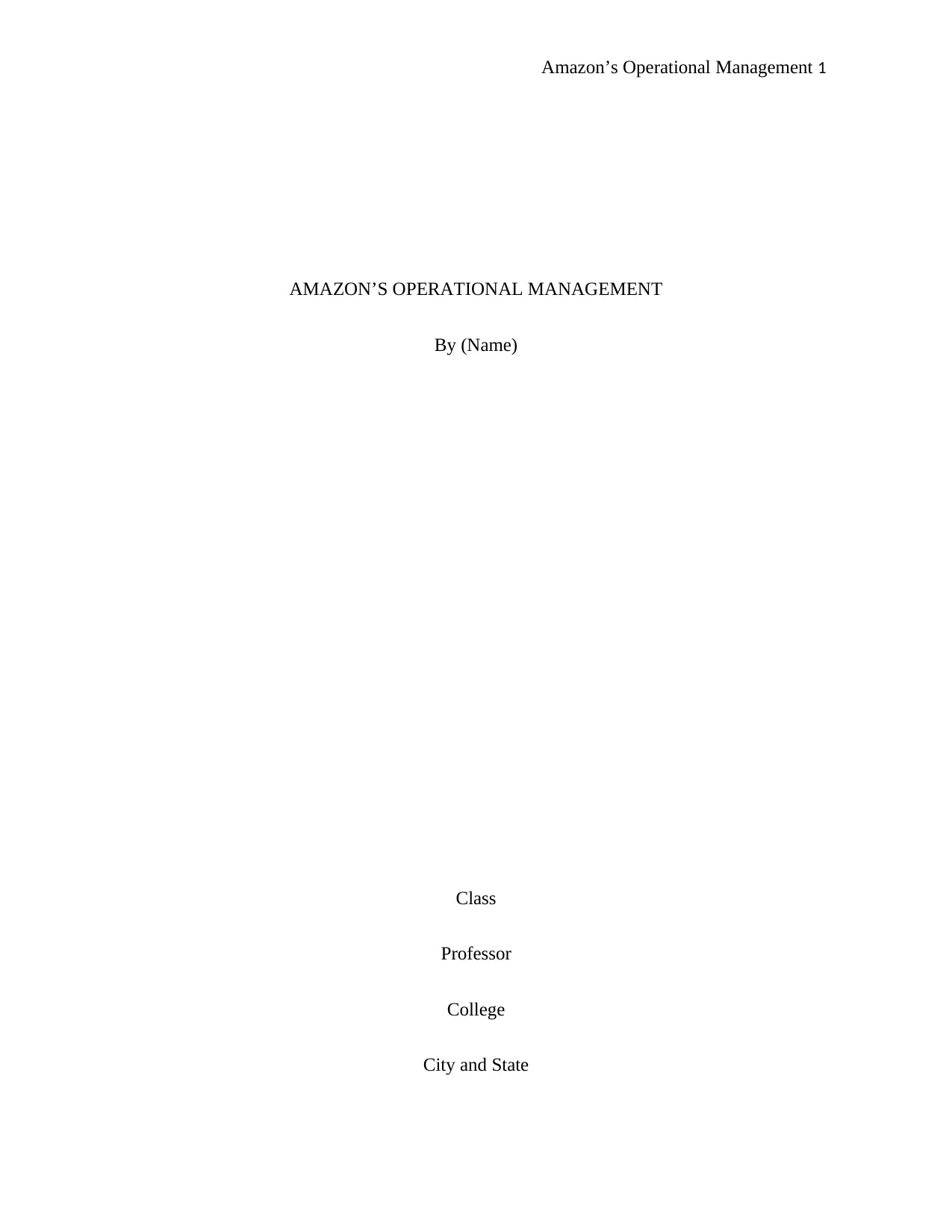
Amazon’s Operational Management 1
AMAZON’S OPERATIONAL MANAGEMENT
By (Name)
Class
Professor
College
City and State
AMAZON’S OPERATIONAL MANAGEMENT
By (Name)
Class
Professor
College
City and State
Paraphrase This Document
Need a fresh take? Get an instant paraphrase of this document with our AI Paraphraser
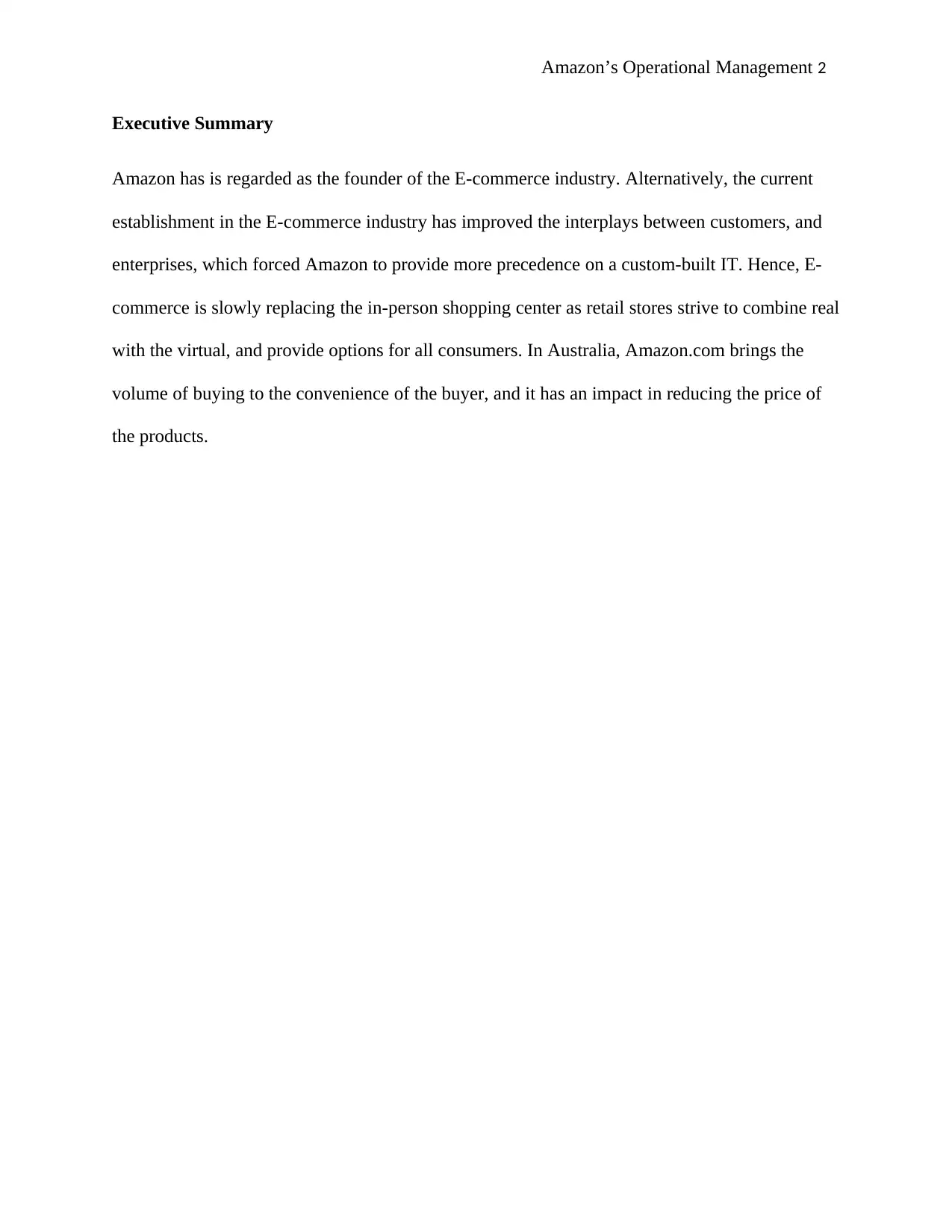
Amazon’s Operational Management 2
Executive Summary
Amazon has is regarded as the founder of the E-commerce industry. Alternatively, the current
establishment in the E-commerce industry has improved the interplays between customers, and
enterprises, which forced Amazon to provide more precedence on a custom-built IT. Hence, E-
commerce is slowly replacing the in-person shopping center as retail stores strive to combine real
with the virtual, and provide options for all consumers. In Australia, Amazon.com brings the
volume of buying to the convenience of the buyer, and it has an impact in reducing the price of
the products.
Executive Summary
Amazon has is regarded as the founder of the E-commerce industry. Alternatively, the current
establishment in the E-commerce industry has improved the interplays between customers, and
enterprises, which forced Amazon to provide more precedence on a custom-built IT. Hence, E-
commerce is slowly replacing the in-person shopping center as retail stores strive to combine real
with the virtual, and provide options for all consumers. In Australia, Amazon.com brings the
volume of buying to the convenience of the buyer, and it has an impact in reducing the price of
the products.
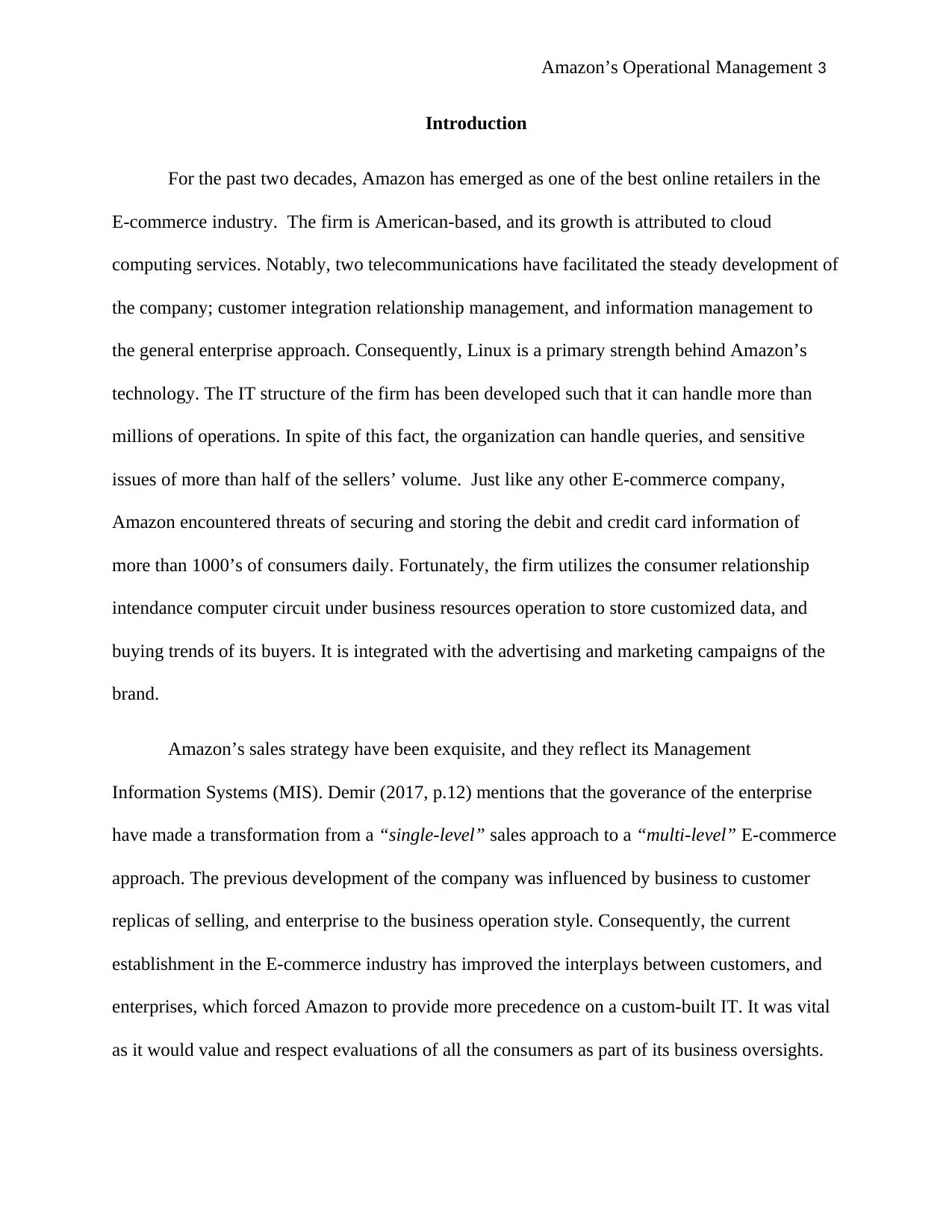
Amazon’s Operational Management 3
Introduction
For the past two decades, Amazon has emerged as one of the best online retailers in the
E-commerce industry. The firm is American-based, and its growth is attributed to cloud
computing services. Notably, two telecommunications have facilitated the steady development of
the company; customer integration relationship management, and information management to
the general enterprise approach. Consequently, Linux is a primary strength behind Amazon’s
technology. The IT structure of the firm has been developed such that it can handle more than
millions of operations. In spite of this fact, the organization can handle queries, and sensitive
issues of more than half of the sellers’ volume. Just like any other E-commerce company,
Amazon encountered threats of securing and storing the debit and credit card information of
more than 1000’s of consumers daily. Fortunately, the firm utilizes the consumer relationship
intendance computer circuit under business resources operation to store customized data, and
buying trends of its buyers. It is integrated with the advertising and marketing campaigns of the
brand.
Amazon’s sales strategy have been exquisite, and they reflect its Management
Information Systems (MIS). Demir (2017, p.12) mentions that the goverance of the enterprise
have made a transformation from a “single-level” sales approach to a “multi-level” E-commerce
approach. The previous development of the company was influenced by business to customer
replicas of selling, and enterprise to the business operation style. Consequently, the current
establishment in the E-commerce industry has improved the interplays between customers, and
enterprises, which forced Amazon to provide more precedence on a custom-built IT. It was vital
as it would value and respect evaluations of all the consumers as part of its business oversights.
Introduction
For the past two decades, Amazon has emerged as one of the best online retailers in the
E-commerce industry. The firm is American-based, and its growth is attributed to cloud
computing services. Notably, two telecommunications have facilitated the steady development of
the company; customer integration relationship management, and information management to
the general enterprise approach. Consequently, Linux is a primary strength behind Amazon’s
technology. The IT structure of the firm has been developed such that it can handle more than
millions of operations. In spite of this fact, the organization can handle queries, and sensitive
issues of more than half of the sellers’ volume. Just like any other E-commerce company,
Amazon encountered threats of securing and storing the debit and credit card information of
more than 1000’s of consumers daily. Fortunately, the firm utilizes the consumer relationship
intendance computer circuit under business resources operation to store customized data, and
buying trends of its buyers. It is integrated with the advertising and marketing campaigns of the
brand.
Amazon’s sales strategy have been exquisite, and they reflect its Management
Information Systems (MIS). Demir (2017, p.12) mentions that the goverance of the enterprise
have made a transformation from a “single-level” sales approach to a “multi-level” E-commerce
approach. The previous development of the company was influenced by business to customer
replicas of selling, and enterprise to the business operation style. Consequently, the current
establishment in the E-commerce industry has improved the interplays between customers, and
enterprises, which forced Amazon to provide more precedence on a custom-built IT. It was vital
as it would value and respect evaluations of all the consumers as part of its business oversights.
⊘ This is a preview!⊘
Do you want full access?
Subscribe today to unlock all pages.

Trusted by 1+ million students worldwide
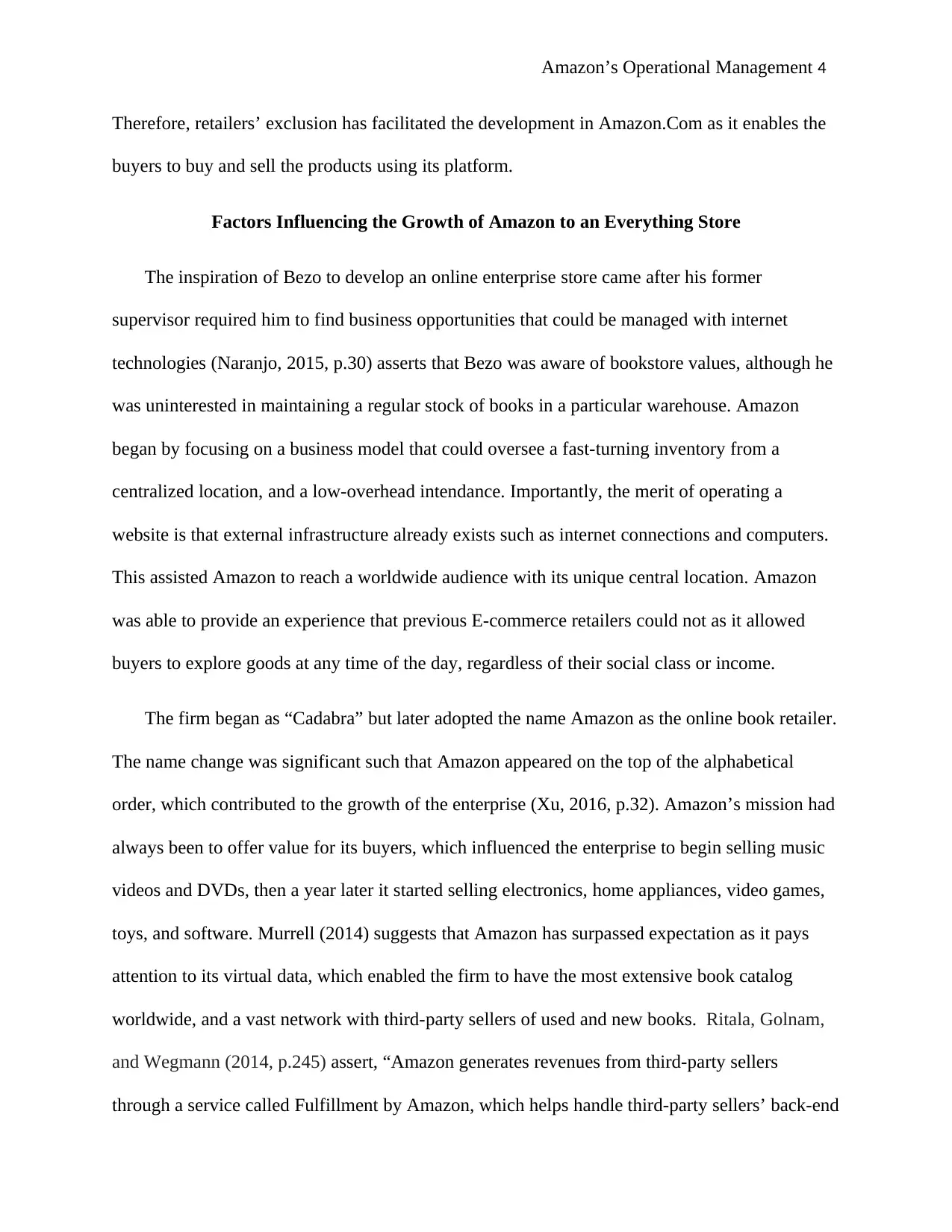
Amazon’s Operational Management 4
Therefore, retailers’ exclusion has facilitated the development in Amazon.Com as it enables the
buyers to buy and sell the products using its platform.
Factors Influencing the Growth of Amazon to an Everything Store
The inspiration of Bezo to develop an online enterprise store came after his former
supervisor required him to find business opportunities that could be managed with internet
technologies (Naranjo, 2015, p.30) asserts that Bezo was aware of bookstore values, although he
was uninterested in maintaining a regular stock of books in a particular warehouse. Amazon
began by focusing on a business model that could oversee a fast-turning inventory from a
centralized location, and a low-overhead intendance. Importantly, the merit of operating a
website is that external infrastructure already exists such as internet connections and computers.
This assisted Amazon to reach a worldwide audience with its unique central location. Amazon
was able to provide an experience that previous E-commerce retailers could not as it allowed
buyers to explore goods at any time of the day, regardless of their social class or income.
The firm began as “Cadabra” but later adopted the name Amazon as the online book retailer.
The name change was significant such that Amazon appeared on the top of the alphabetical
order, which contributed to the growth of the enterprise (Xu, 2016, p.32). Amazon’s mission had
always been to offer value for its buyers, which influenced the enterprise to begin selling music
videos and DVDs, then a year later it started selling electronics, home appliances, video games,
toys, and software. Murrell (2014) suggests that Amazon has surpassed expectation as it pays
attention to its virtual data, which enabled the firm to have the most extensive book catalog
worldwide, and a vast network with third-party sellers of used and new books. Ritala, Golnam,
and Wegmann (2014, p.245) assert, “Amazon generates revenues from third-party sellers
through a service called Fulfillment by Amazon, which helps handle third-party sellers’ back-end
Therefore, retailers’ exclusion has facilitated the development in Amazon.Com as it enables the
buyers to buy and sell the products using its platform.
Factors Influencing the Growth of Amazon to an Everything Store
The inspiration of Bezo to develop an online enterprise store came after his former
supervisor required him to find business opportunities that could be managed with internet
technologies (Naranjo, 2015, p.30) asserts that Bezo was aware of bookstore values, although he
was uninterested in maintaining a regular stock of books in a particular warehouse. Amazon
began by focusing on a business model that could oversee a fast-turning inventory from a
centralized location, and a low-overhead intendance. Importantly, the merit of operating a
website is that external infrastructure already exists such as internet connections and computers.
This assisted Amazon to reach a worldwide audience with its unique central location. Amazon
was able to provide an experience that previous E-commerce retailers could not as it allowed
buyers to explore goods at any time of the day, regardless of their social class or income.
The firm began as “Cadabra” but later adopted the name Amazon as the online book retailer.
The name change was significant such that Amazon appeared on the top of the alphabetical
order, which contributed to the growth of the enterprise (Xu, 2016, p.32). Amazon’s mission had
always been to offer value for its buyers, which influenced the enterprise to begin selling music
videos and DVDs, then a year later it started selling electronics, home appliances, video games,
toys, and software. Murrell (2014) suggests that Amazon has surpassed expectation as it pays
attention to its virtual data, which enabled the firm to have the most extensive book catalog
worldwide, and a vast network with third-party sellers of used and new books. Ritala, Golnam,
and Wegmann (2014, p.245) assert, “Amazon generates revenues from third-party sellers
through a service called Fulfillment by Amazon, which helps handle third-party sellers’ back-end
Paraphrase This Document
Need a fresh take? Get an instant paraphrase of this document with our AI Paraphraser
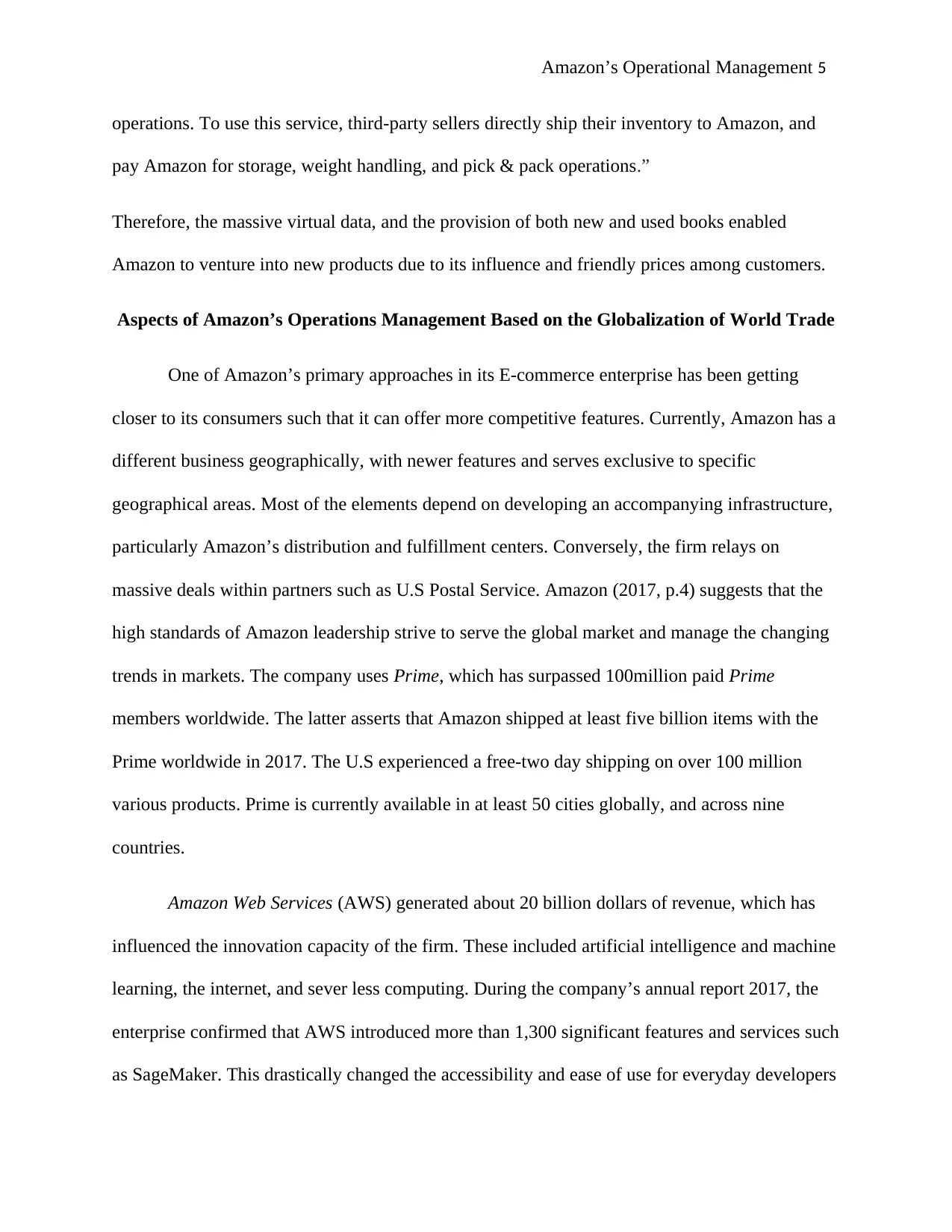
Amazon’s Operational Management 5
operations. To use this service, third-party sellers directly ship their inventory to Amazon, and
pay Amazon for storage, weight handling, and pick & pack operations.”
Therefore, the massive virtual data, and the provision of both new and used books enabled
Amazon to venture into new products due to its influence and friendly prices among customers.
Aspects of Amazon’s Operations Management Based on the Globalization of World Trade
One of Amazon’s primary approaches in its E-commerce enterprise has been getting
closer to its consumers such that it can offer more competitive features. Currently, Amazon has a
different business geographically, with newer features and serves exclusive to specific
geographical areas. Most of the elements depend on developing an accompanying infrastructure,
particularly Amazon’s distribution and fulfillment centers. Conversely, the firm relays on
massive deals within partners such as U.S Postal Service. Amazon (2017, p.4) suggests that the
high standards of Amazon leadership strive to serve the global market and manage the changing
trends in markets. The company uses Prime, which has surpassed 100million paid Prime
members worldwide. The latter asserts that Amazon shipped at least five billion items with the
Prime worldwide in 2017. The U.S experienced a free-two day shipping on over 100 million
various products. Prime is currently available in at least 50 cities globally, and across nine
countries.
Amazon Web Services (AWS) generated about 20 billion dollars of revenue, which has
influenced the innovation capacity of the firm. These included artificial intelligence and machine
learning, the internet, and sever less computing. During the company’s annual report 2017, the
enterprise confirmed that AWS introduced more than 1,300 significant features and services such
as SageMaker. This drastically changed the accessibility and ease of use for everyday developers
operations. To use this service, third-party sellers directly ship their inventory to Amazon, and
pay Amazon for storage, weight handling, and pick & pack operations.”
Therefore, the massive virtual data, and the provision of both new and used books enabled
Amazon to venture into new products due to its influence and friendly prices among customers.
Aspects of Amazon’s Operations Management Based on the Globalization of World Trade
One of Amazon’s primary approaches in its E-commerce enterprise has been getting
closer to its consumers such that it can offer more competitive features. Currently, Amazon has a
different business geographically, with newer features and serves exclusive to specific
geographical areas. Most of the elements depend on developing an accompanying infrastructure,
particularly Amazon’s distribution and fulfillment centers. Conversely, the firm relays on
massive deals within partners such as U.S Postal Service. Amazon (2017, p.4) suggests that the
high standards of Amazon leadership strive to serve the global market and manage the changing
trends in markets. The company uses Prime, which has surpassed 100million paid Prime
members worldwide. The latter asserts that Amazon shipped at least five billion items with the
Prime worldwide in 2017. The U.S experienced a free-two day shipping on over 100 million
various products. Prime is currently available in at least 50 cities globally, and across nine
countries.
Amazon Web Services (AWS) generated about 20 billion dollars of revenue, which has
influenced the innovation capacity of the firm. These included artificial intelligence and machine
learning, the internet, and sever less computing. During the company’s annual report 2017, the
enterprise confirmed that AWS introduced more than 1,300 significant features and services such
as SageMaker. This drastically changed the accessibility and ease of use for everyday developers
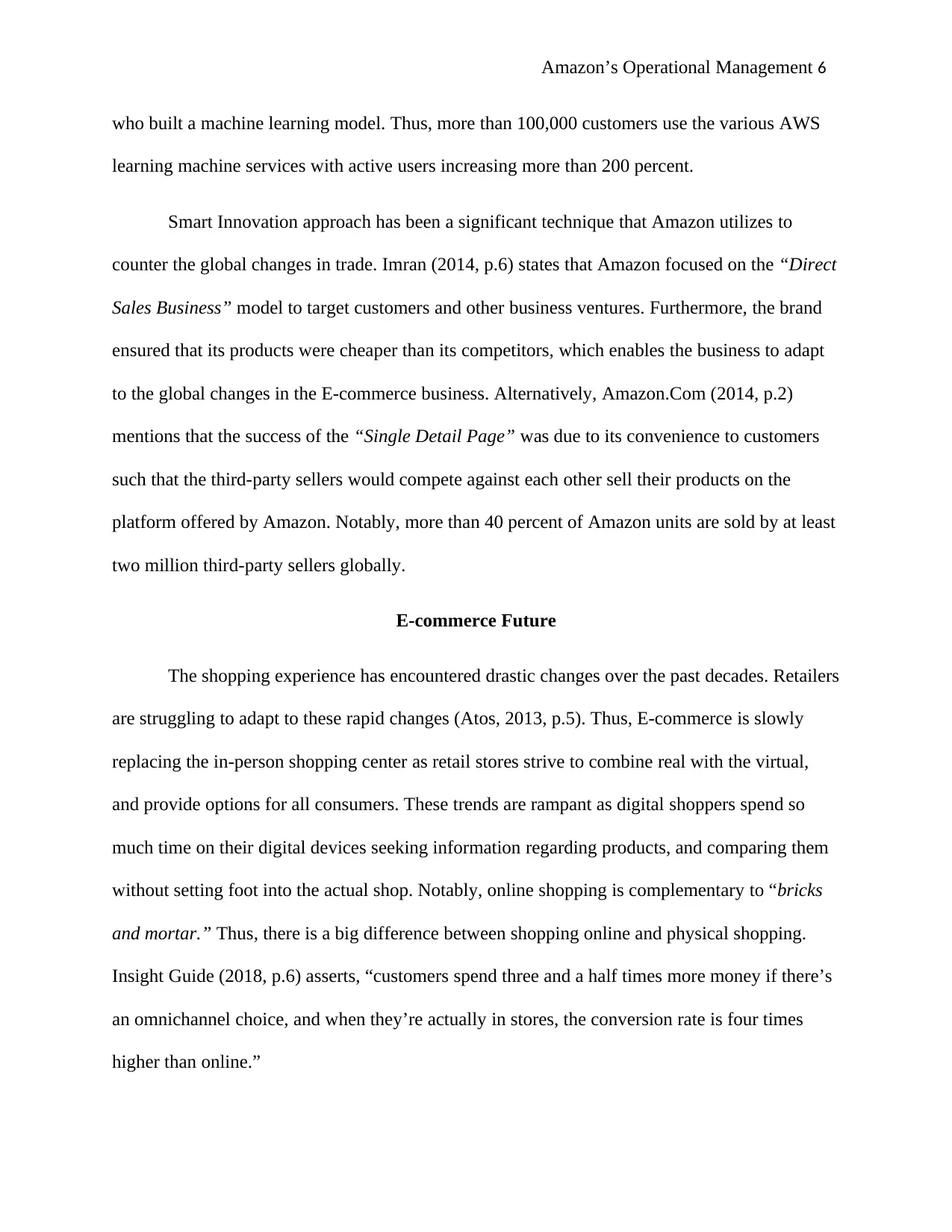
Amazon’s Operational Management 6
who built a machine learning model. Thus, more than 100,000 customers use the various AWS
learning machine services with active users increasing more than 200 percent.
Smart Innovation approach has been a significant technique that Amazon utilizes to
counter the global changes in trade. Imran (2014, p.6) states that Amazon focused on the “Direct
Sales Business” model to target customers and other business ventures. Furthermore, the brand
ensured that its products were cheaper than its competitors, which enables the business to adapt
to the global changes in the E-commerce business. Alternatively, Amazon.Com (2014, p.2)
mentions that the success of the “Single Detail Page” was due to its convenience to customers
such that the third-party sellers would compete against each other sell their products on the
platform offered by Amazon. Notably, more than 40 percent of Amazon units are sold by at least
two million third-party sellers globally.
E-commerce Future
The shopping experience has encountered drastic changes over the past decades. Retailers
are struggling to adapt to these rapid changes (Atos, 2013, p.5). Thus, E-commerce is slowly
replacing the in-person shopping center as retail stores strive to combine real with the virtual,
and provide options for all consumers. These trends are rampant as digital shoppers spend so
much time on their digital devices seeking information regarding products, and comparing them
without setting foot into the actual shop. Notably, online shopping is complementary to “bricks
and mortar.” Thus, there is a big difference between shopping online and physical shopping.
Insight Guide (2018, p.6) asserts, “customers spend three and a half times more money if there’s
an omnichannel choice, and when they’re actually in stores, the conversion rate is four times
higher than online.”
who built a machine learning model. Thus, more than 100,000 customers use the various AWS
learning machine services with active users increasing more than 200 percent.
Smart Innovation approach has been a significant technique that Amazon utilizes to
counter the global changes in trade. Imran (2014, p.6) states that Amazon focused on the “Direct
Sales Business” model to target customers and other business ventures. Furthermore, the brand
ensured that its products were cheaper than its competitors, which enables the business to adapt
to the global changes in the E-commerce business. Alternatively, Amazon.Com (2014, p.2)
mentions that the success of the “Single Detail Page” was due to its convenience to customers
such that the third-party sellers would compete against each other sell their products on the
platform offered by Amazon. Notably, more than 40 percent of Amazon units are sold by at least
two million third-party sellers globally.
E-commerce Future
The shopping experience has encountered drastic changes over the past decades. Retailers
are struggling to adapt to these rapid changes (Atos, 2013, p.5). Thus, E-commerce is slowly
replacing the in-person shopping center as retail stores strive to combine real with the virtual,
and provide options for all consumers. These trends are rampant as digital shoppers spend so
much time on their digital devices seeking information regarding products, and comparing them
without setting foot into the actual shop. Notably, online shopping is complementary to “bricks
and mortar.” Thus, there is a big difference between shopping online and physical shopping.
Insight Guide (2018, p.6) asserts, “customers spend three and a half times more money if there’s
an omnichannel choice, and when they’re actually in stores, the conversion rate is four times
higher than online.”
⊘ This is a preview!⊘
Do you want full access?
Subscribe today to unlock all pages.

Trusted by 1+ million students worldwide
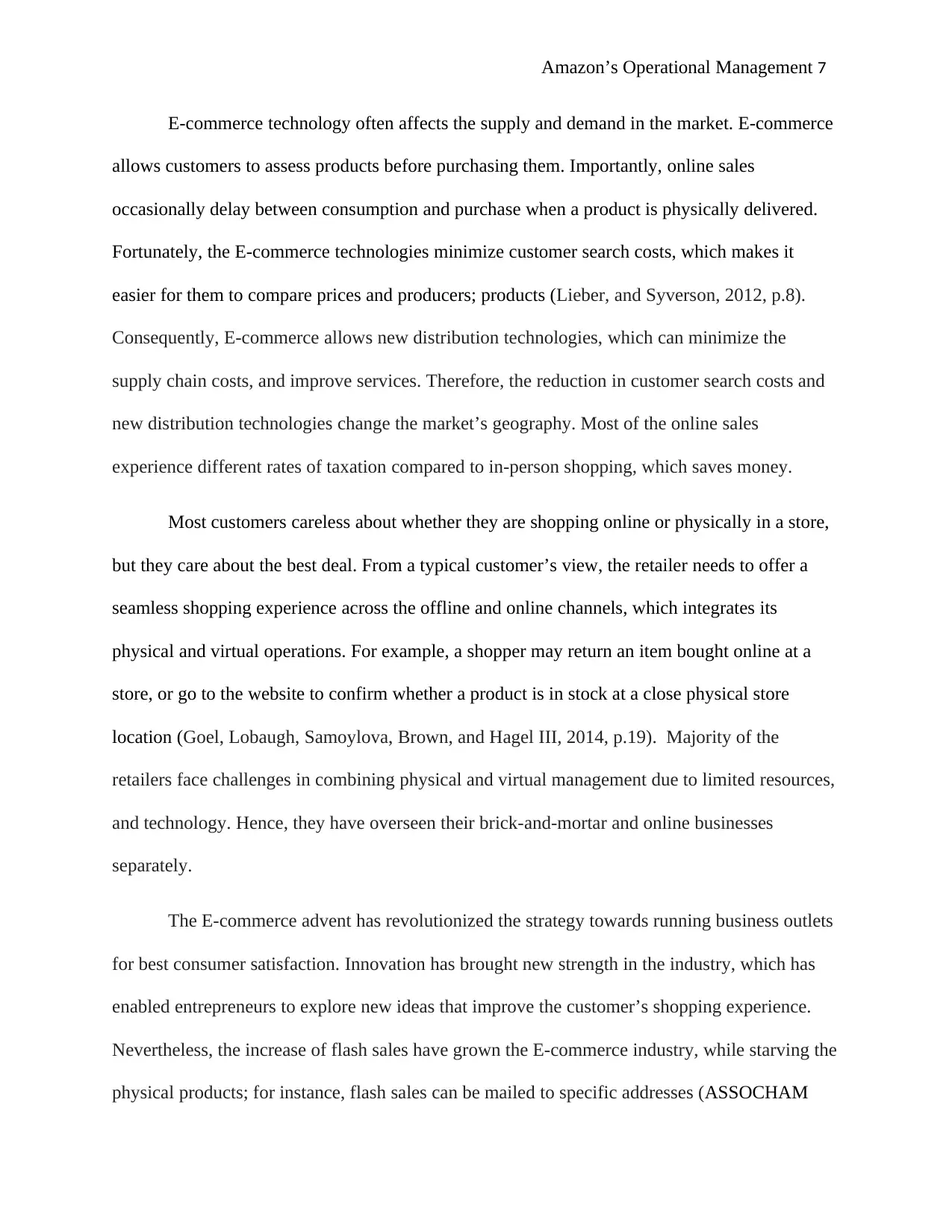
Amazon’s Operational Management 7
E-commerce technology often affects the supply and demand in the market. E-commerce
allows customers to assess products before purchasing them. Importantly, online sales
occasionally delay between consumption and purchase when a product is physically delivered.
Fortunately, the E-commerce technologies minimize customer search costs, which makes it
easier for them to compare prices and producers; products (Lieber, and Syverson, 2012, p.8).
Consequently, E-commerce allows new distribution technologies, which can minimize the
supply chain costs, and improve services. Therefore, the reduction in customer search costs and
new distribution technologies change the market’s geography. Most of the online sales
experience different rates of taxation compared to in-person shopping, which saves money.
Most customers careless about whether they are shopping online or physically in a store,
but they care about the best deal. From a typical customer’s view, the retailer needs to offer a
seamless shopping experience across the offline and online channels, which integrates its
physical and virtual operations. For example, a shopper may return an item bought online at a
store, or go to the website to confirm whether a product is in stock at a close physical store
location (Goel, Lobaugh, Samoylova, Brown, and Hagel III, 2014, p.19). Majority of the
retailers face challenges in combining physical and virtual management due to limited resources,
and technology. Hence, they have overseen their brick-and-mortar and online businesses
separately.
The E-commerce advent has revolutionized the strategy towards running business outlets
for best consumer satisfaction. Innovation has brought new strength in the industry, which has
enabled entrepreneurs to explore new ideas that improve the customer’s shopping experience.
Nevertheless, the increase of flash sales have grown the E-commerce industry, while starving the
physical products; for instance, flash sales can be mailed to specific addresses (ASSOCHAM
E-commerce technology often affects the supply and demand in the market. E-commerce
allows customers to assess products before purchasing them. Importantly, online sales
occasionally delay between consumption and purchase when a product is physically delivered.
Fortunately, the E-commerce technologies minimize customer search costs, which makes it
easier for them to compare prices and producers; products (Lieber, and Syverson, 2012, p.8).
Consequently, E-commerce allows new distribution technologies, which can minimize the
supply chain costs, and improve services. Therefore, the reduction in customer search costs and
new distribution technologies change the market’s geography. Most of the online sales
experience different rates of taxation compared to in-person shopping, which saves money.
Most customers careless about whether they are shopping online or physically in a store,
but they care about the best deal. From a typical customer’s view, the retailer needs to offer a
seamless shopping experience across the offline and online channels, which integrates its
physical and virtual operations. For example, a shopper may return an item bought online at a
store, or go to the website to confirm whether a product is in stock at a close physical store
location (Goel, Lobaugh, Samoylova, Brown, and Hagel III, 2014, p.19). Majority of the
retailers face challenges in combining physical and virtual management due to limited resources,
and technology. Hence, they have overseen their brick-and-mortar and online businesses
separately.
The E-commerce advent has revolutionized the strategy towards running business outlets
for best consumer satisfaction. Innovation has brought new strength in the industry, which has
enabled entrepreneurs to explore new ideas that improve the customer’s shopping experience.
Nevertheless, the increase of flash sales have grown the E-commerce industry, while starving the
physical products; for instance, flash sales can be mailed to specific addresses (ASSOCHAM
Paraphrase This Document
Need a fresh take? Get an instant paraphrase of this document with our AI Paraphraser
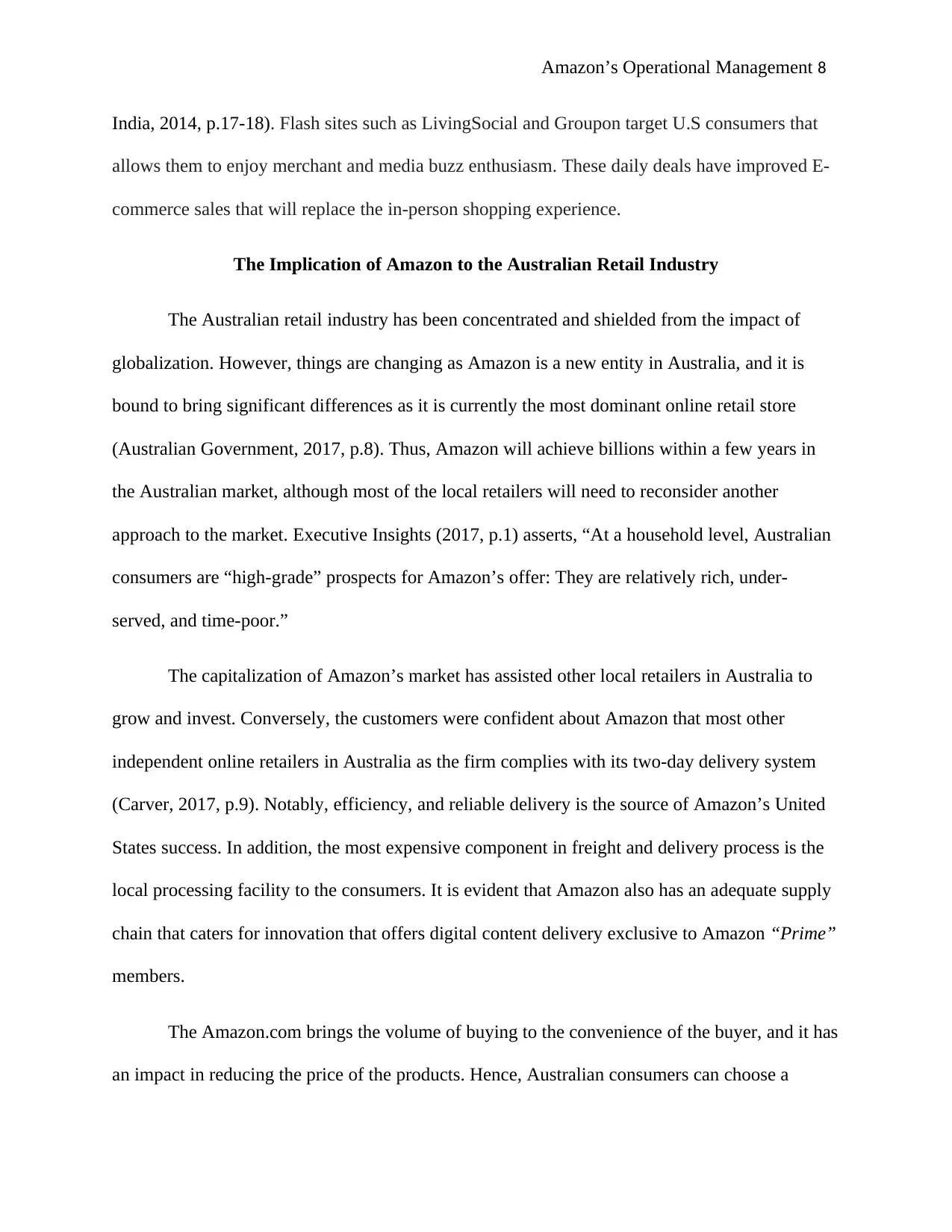
Amazon’s Operational Management 8
India, 2014, p.17-18). Flash sites such as LivingSocial and Groupon target U.S consumers that
allows them to enjoy merchant and media buzz enthusiasm. These daily deals have improved E-
commerce sales that will replace the in-person shopping experience.
The Implication of Amazon to the Australian Retail Industry
The Australian retail industry has been concentrated and shielded from the impact of
globalization. However, things are changing as Amazon is a new entity in Australia, and it is
bound to bring significant differences as it is currently the most dominant online retail store
(Australian Government, 2017, p.8). Thus, Amazon will achieve billions within a few years in
the Australian market, although most of the local retailers will need to reconsider another
approach to the market. Executive Insights (2017, p.1) asserts, “At a household level, Australian
consumers are “high-grade” prospects for Amazon’s offer: They are relatively rich, under-
served, and time-poor.”
The capitalization of Amazon’s market has assisted other local retailers in Australia to
grow and invest. Conversely, the customers were confident about Amazon that most other
independent online retailers in Australia as the firm complies with its two-day delivery system
(Carver, 2017, p.9). Notably, efficiency, and reliable delivery is the source of Amazon’s United
States success. In addition, the most expensive component in freight and delivery process is the
local processing facility to the consumers. It is evident that Amazon also has an adequate supply
chain that caters for innovation that offers digital content delivery exclusive to Amazon “Prime”
members.
The Amazon.com brings the volume of buying to the convenience of the buyer, and it has
an impact in reducing the price of the products. Hence, Australian consumers can choose a
India, 2014, p.17-18). Flash sites such as LivingSocial and Groupon target U.S consumers that
allows them to enjoy merchant and media buzz enthusiasm. These daily deals have improved E-
commerce sales that will replace the in-person shopping experience.
The Implication of Amazon to the Australian Retail Industry
The Australian retail industry has been concentrated and shielded from the impact of
globalization. However, things are changing as Amazon is a new entity in Australia, and it is
bound to bring significant differences as it is currently the most dominant online retail store
(Australian Government, 2017, p.8). Thus, Amazon will achieve billions within a few years in
the Australian market, although most of the local retailers will need to reconsider another
approach to the market. Executive Insights (2017, p.1) asserts, “At a household level, Australian
consumers are “high-grade” prospects for Amazon’s offer: They are relatively rich, under-
served, and time-poor.”
The capitalization of Amazon’s market has assisted other local retailers in Australia to
grow and invest. Conversely, the customers were confident about Amazon that most other
independent online retailers in Australia as the firm complies with its two-day delivery system
(Carver, 2017, p.9). Notably, efficiency, and reliable delivery is the source of Amazon’s United
States success. In addition, the most expensive component in freight and delivery process is the
local processing facility to the consumers. It is evident that Amazon also has an adequate supply
chain that caters for innovation that offers digital content delivery exclusive to Amazon “Prime”
members.
The Amazon.com brings the volume of buying to the convenience of the buyer, and it has
an impact in reducing the price of the products. Hence, Australian consumers can choose a
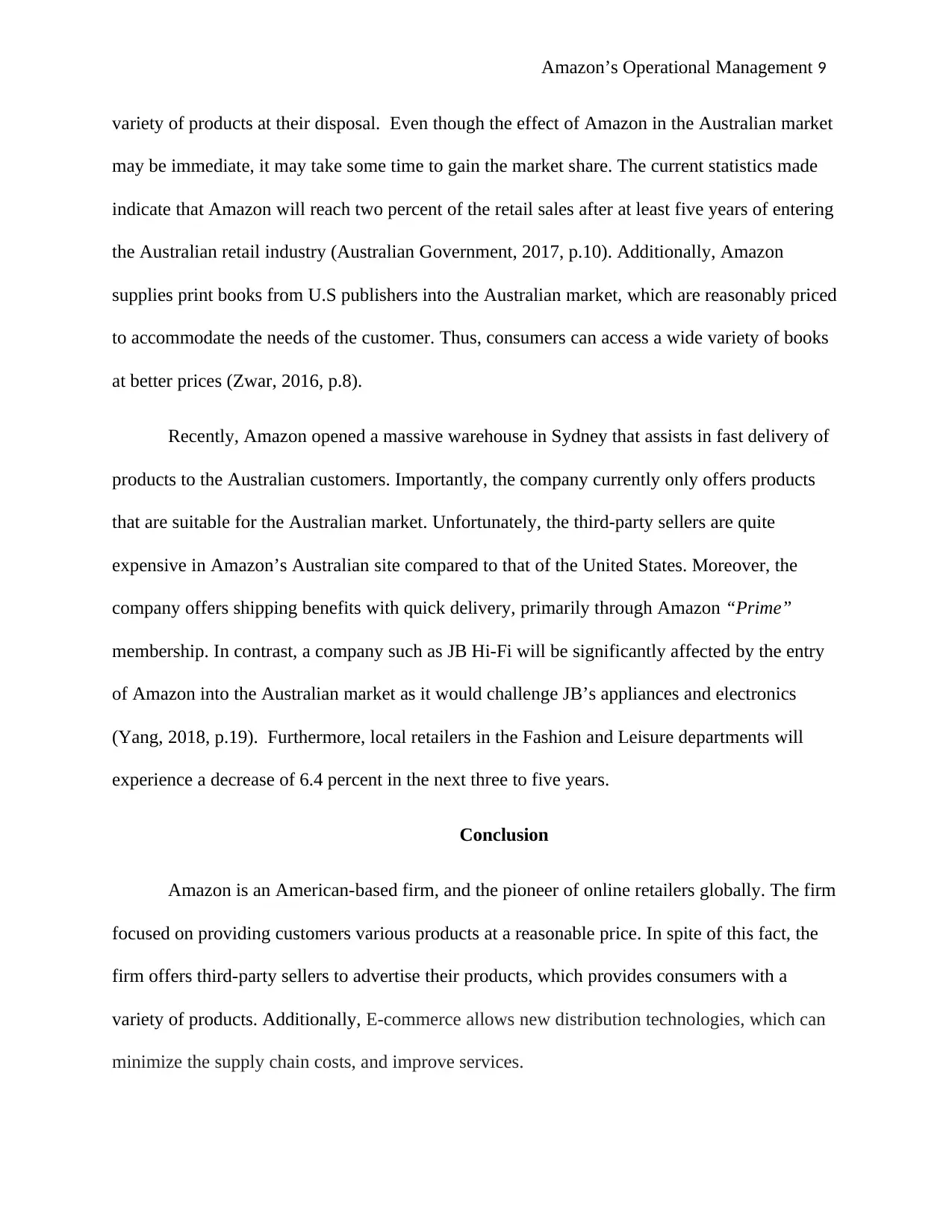
Amazon’s Operational Management 9
variety of products at their disposal. Even though the effect of Amazon in the Australian market
may be immediate, it may take some time to gain the market share. The current statistics made
indicate that Amazon will reach two percent of the retail sales after at least five years of entering
the Australian retail industry (Australian Government, 2017, p.10). Additionally, Amazon
supplies print books from U.S publishers into the Australian market, which are reasonably priced
to accommodate the needs of the customer. Thus, consumers can access a wide variety of books
at better prices (Zwar, 2016, p.8).
Recently, Amazon opened a massive warehouse in Sydney that assists in fast delivery of
products to the Australian customers. Importantly, the company currently only offers products
that are suitable for the Australian market. Unfortunately, the third-party sellers are quite
expensive in Amazon’s Australian site compared to that of the United States. Moreover, the
company offers shipping benefits with quick delivery, primarily through Amazon “Prime”
membership. In contrast, a company such as JB Hi-Fi will be significantly affected by the entry
of Amazon into the Australian market as it would challenge JB’s appliances and electronics
(Yang, 2018, p.19). Furthermore, local retailers in the Fashion and Leisure departments will
experience a decrease of 6.4 percent in the next three to five years.
Conclusion
Amazon is an American-based firm, and the pioneer of online retailers globally. The firm
focused on providing customers various products at a reasonable price. In spite of this fact, the
firm offers third-party sellers to advertise their products, which provides consumers with a
variety of products. Additionally, E-commerce allows new distribution technologies, which can
minimize the supply chain costs, and improve services.
variety of products at their disposal. Even though the effect of Amazon in the Australian market
may be immediate, it may take some time to gain the market share. The current statistics made
indicate that Amazon will reach two percent of the retail sales after at least five years of entering
the Australian retail industry (Australian Government, 2017, p.10). Additionally, Amazon
supplies print books from U.S publishers into the Australian market, which are reasonably priced
to accommodate the needs of the customer. Thus, consumers can access a wide variety of books
at better prices (Zwar, 2016, p.8).
Recently, Amazon opened a massive warehouse in Sydney that assists in fast delivery of
products to the Australian customers. Importantly, the company currently only offers products
that are suitable for the Australian market. Unfortunately, the third-party sellers are quite
expensive in Amazon’s Australian site compared to that of the United States. Moreover, the
company offers shipping benefits with quick delivery, primarily through Amazon “Prime”
membership. In contrast, a company such as JB Hi-Fi will be significantly affected by the entry
of Amazon into the Australian market as it would challenge JB’s appliances and electronics
(Yang, 2018, p.19). Furthermore, local retailers in the Fashion and Leisure departments will
experience a decrease of 6.4 percent in the next three to five years.
Conclusion
Amazon is an American-based firm, and the pioneer of online retailers globally. The firm
focused on providing customers various products at a reasonable price. In spite of this fact, the
firm offers third-party sellers to advertise their products, which provides consumers with a
variety of products. Additionally, E-commerce allows new distribution technologies, which can
minimize the supply chain costs, and improve services.
⊘ This is a preview!⊘
Do you want full access?
Subscribe today to unlock all pages.

Trusted by 1+ million students worldwide
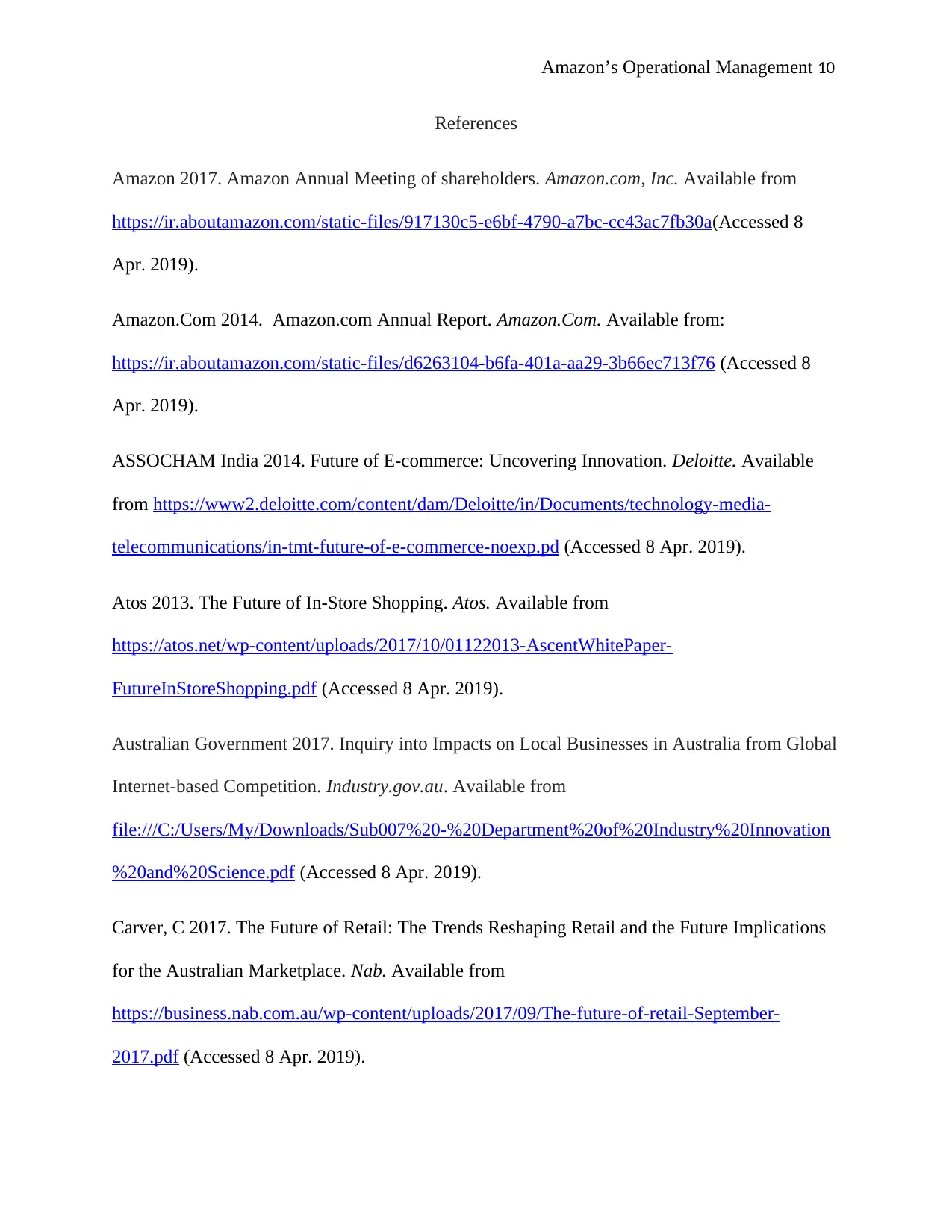
Amazon’s Operational Management 10
References
Amazon 2017. Amazon Annual Meeting of shareholders. Amazon.com, Inc. Available from
https://ir.aboutamazon.com/static-files/917130c5-e6bf-4790-a7bc-cc43ac7fb30a(Accessed 8
Apr. 2019).
Amazon.Com 2014. Amazon.com Annual Report. Amazon.Com. Available from:
https://ir.aboutamazon.com/static-files/d6263104-b6fa-401a-aa29-3b66ec713f76 (Accessed 8
Apr. 2019).
ASSOCHAM India 2014. Future of E-commerce: Uncovering Innovation. Deloitte. Available
from https://www2.deloitte.com/content/dam/Deloitte/in/Documents/technology-media-
telecommunications/in-tmt-future-of-e-commerce-noexp.pd (Accessed 8 Apr. 2019).
Atos 2013. The Future of In-Store Shopping. Atos. Available from
https://atos.net/wp-content/uploads/2017/10/01122013-AscentWhitePaper-
FutureInStoreShopping.pdf (Accessed 8 Apr. 2019).
Australian Government 2017. Inquiry into Impacts on Local Businesses in Australia from Global
Internet-based Competition. Industry.gov.au. Available from
file:///C:/Users/My/Downloads/Sub007%20-%20Department%20of%20Industry%20Innovation
%20and%20Science.pdf (Accessed 8 Apr. 2019).
Carver, C 2017. The Future of Retail: The Trends Reshaping Retail and the Future Implications
for the Australian Marketplace. Nab. Available from
https://business.nab.com.au/wp-content/uploads/2017/09/The-future-of-retail-September-
2017.pdf (Accessed 8 Apr. 2019).
References
Amazon 2017. Amazon Annual Meeting of shareholders. Amazon.com, Inc. Available from
https://ir.aboutamazon.com/static-files/917130c5-e6bf-4790-a7bc-cc43ac7fb30a(Accessed 8
Apr. 2019).
Amazon.Com 2014. Amazon.com Annual Report. Amazon.Com. Available from:
https://ir.aboutamazon.com/static-files/d6263104-b6fa-401a-aa29-3b66ec713f76 (Accessed 8
Apr. 2019).
ASSOCHAM India 2014. Future of E-commerce: Uncovering Innovation. Deloitte. Available
from https://www2.deloitte.com/content/dam/Deloitte/in/Documents/technology-media-
telecommunications/in-tmt-future-of-e-commerce-noexp.pd (Accessed 8 Apr. 2019).
Atos 2013. The Future of In-Store Shopping. Atos. Available from
https://atos.net/wp-content/uploads/2017/10/01122013-AscentWhitePaper-
FutureInStoreShopping.pdf (Accessed 8 Apr. 2019).
Australian Government 2017. Inquiry into Impacts on Local Businesses in Australia from Global
Internet-based Competition. Industry.gov.au. Available from
file:///C:/Users/My/Downloads/Sub007%20-%20Department%20of%20Industry%20Innovation
%20and%20Science.pdf (Accessed 8 Apr. 2019).
Carver, C 2017. The Future of Retail: The Trends Reshaping Retail and the Future Implications
for the Australian Marketplace. Nab. Available from
https://business.nab.com.au/wp-content/uploads/2017/09/The-future-of-retail-September-
2017.pdf (Accessed 8 Apr. 2019).
Paraphrase This Document
Need a fresh take? Get an instant paraphrase of this document with our AI Paraphraser
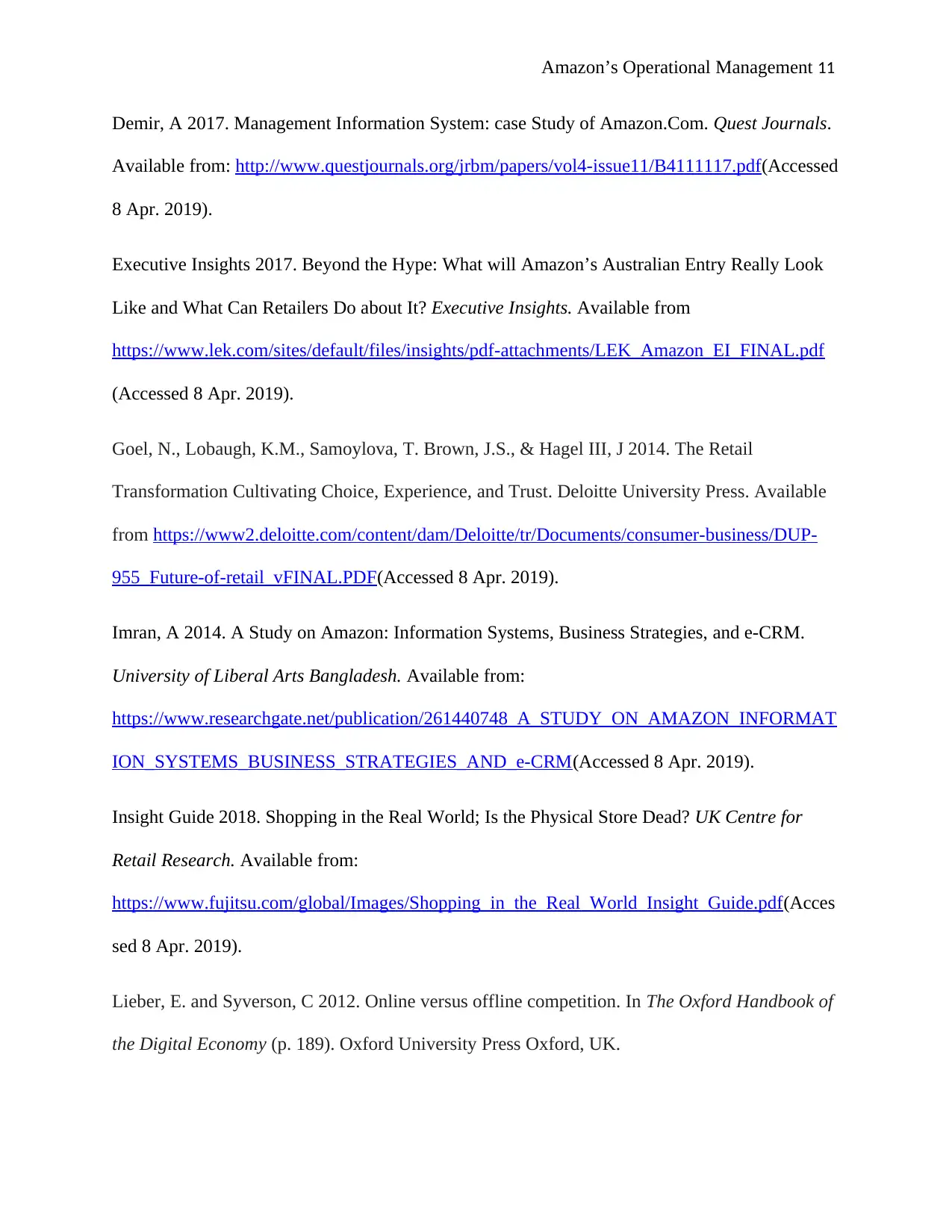
Amazon’s Operational Management 11
Demir, A 2017. Management Information System: case Study of Amazon.Com. Quest Journals.
Available from: http://www.questjournals.org/jrbm/papers/vol4-issue11/B4111117.pdf(Accessed
8 Apr. 2019).
Executive Insights 2017. Beyond the Hype: What will Amazon’s Australian Entry Really Look
Like and What Can Retailers Do about It? Executive Insights. Available from
https://www.lek.com/sites/default/files/insights/pdf-attachments/LEK_Amazon_EI_FINAL.pdf
(Accessed 8 Apr. 2019).
Goel, N., Lobaugh, K.M., Samoylova, T. Brown, J.S., & Hagel III, J 2014. The Retail
Transformation Cultivating Choice, Experience, and Trust. Deloitte University Press. Available
from https://www2.deloitte.com/content/dam/Deloitte/tr/Documents/consumer-business/DUP-
955_Future-of-retail_vFINAL.PDF(Accessed 8 Apr. 2019).
Imran, A 2014. A Study on Amazon: Information Systems, Business Strategies, and e-CRM.
University of Liberal Arts Bangladesh. Available from:
https://www.researchgate.net/publication/261440748_A_STUDY_ON_AMAZON_INFORMAT
ION_SYSTEMS_BUSINESS_STRATEGIES_AND_e-CRM(Accessed 8 Apr. 2019).
Insight Guide 2018. Shopping in the Real World; Is the Physical Store Dead? UK Centre for
Retail Research. Available from:
https://www.fujitsu.com/global/Images/Shopping_in_the_Real_World_Insight_Guide.pdf(Acces
sed 8 Apr. 2019).
Lieber, E. and Syverson, C 2012. Online versus offline competition. In The Oxford Handbook of
the Digital Economy (p. 189). Oxford University Press Oxford, UK.
Demir, A 2017. Management Information System: case Study of Amazon.Com. Quest Journals.
Available from: http://www.questjournals.org/jrbm/papers/vol4-issue11/B4111117.pdf(Accessed
8 Apr. 2019).
Executive Insights 2017. Beyond the Hype: What will Amazon’s Australian Entry Really Look
Like and What Can Retailers Do about It? Executive Insights. Available from
https://www.lek.com/sites/default/files/insights/pdf-attachments/LEK_Amazon_EI_FINAL.pdf
(Accessed 8 Apr. 2019).
Goel, N., Lobaugh, K.M., Samoylova, T. Brown, J.S., & Hagel III, J 2014. The Retail
Transformation Cultivating Choice, Experience, and Trust. Deloitte University Press. Available
from https://www2.deloitte.com/content/dam/Deloitte/tr/Documents/consumer-business/DUP-
955_Future-of-retail_vFINAL.PDF(Accessed 8 Apr. 2019).
Imran, A 2014. A Study on Amazon: Information Systems, Business Strategies, and e-CRM.
University of Liberal Arts Bangladesh. Available from:
https://www.researchgate.net/publication/261440748_A_STUDY_ON_AMAZON_INFORMAT
ION_SYSTEMS_BUSINESS_STRATEGIES_AND_e-CRM(Accessed 8 Apr. 2019).
Insight Guide 2018. Shopping in the Real World; Is the Physical Store Dead? UK Centre for
Retail Research. Available from:
https://www.fujitsu.com/global/Images/Shopping_in_the_Real_World_Insight_Guide.pdf(Acces
sed 8 Apr. 2019).
Lieber, E. and Syverson, C 2012. Online versus offline competition. In The Oxford Handbook of
the Digital Economy (p. 189). Oxford University Press Oxford, UK.
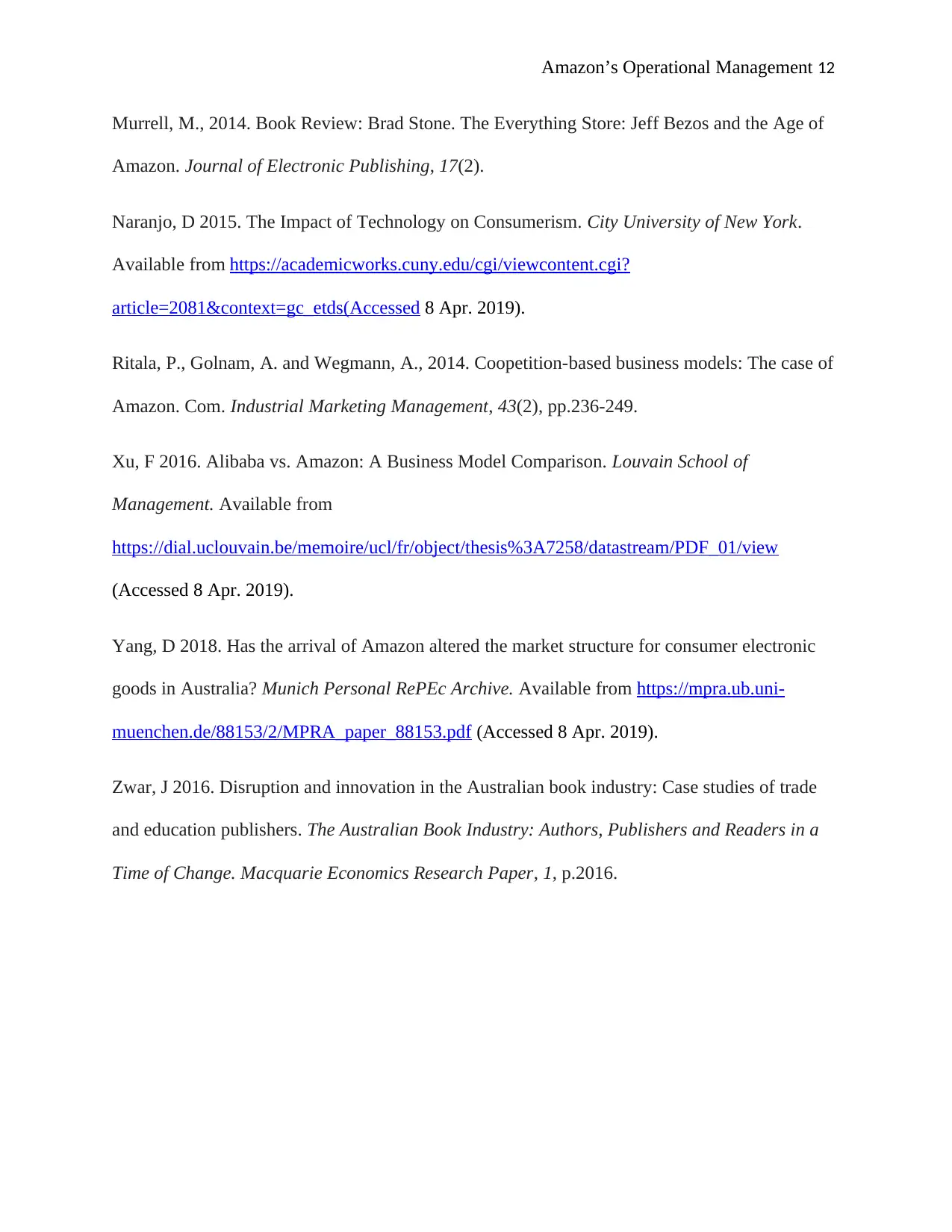
Amazon’s Operational Management 12
Murrell, M., 2014. Book Review: Brad Stone. The Everything Store: Jeff Bezos and the Age of
Amazon. Journal of Electronic Publishing, 17(2).
Naranjo, D 2015. The Impact of Technology on Consumerism. City University of New York.
Available from https://academicworks.cuny.edu/cgi/viewcontent.cgi?
article=2081&context=gc_etds(Accessed 8 Apr. 2019).
Ritala, P., Golnam, A. and Wegmann, A., 2014. Coopetition-based business models: The case of
Amazon. Com. Industrial Marketing Management, 43(2), pp.236-249.
Xu, F 2016. Alibaba vs. Amazon: A Business Model Comparison. Louvain School of
Management. Available from
https://dial.uclouvain.be/memoire/ucl/fr/object/thesis%3A7258/datastream/PDF_01/view
(Accessed 8 Apr. 2019).
Yang, D 2018. Has the arrival of Amazon altered the market structure for consumer electronic
goods in Australia? Munich Personal RePEc Archive. Available from https://mpra.ub.uni-
muenchen.de/88153/2/MPRA_paper_88153.pdf (Accessed 8 Apr. 2019).
Zwar, J 2016. Disruption and innovation in the Australian book industry: Case studies of trade
and education publishers. The Australian Book Industry: Authors, Publishers and Readers in a
Time of Change. Macquarie Economics Research Paper, 1, p.2016.
Murrell, M., 2014. Book Review: Brad Stone. The Everything Store: Jeff Bezos and the Age of
Amazon. Journal of Electronic Publishing, 17(2).
Naranjo, D 2015. The Impact of Technology on Consumerism. City University of New York.
Available from https://academicworks.cuny.edu/cgi/viewcontent.cgi?
article=2081&context=gc_etds(Accessed 8 Apr. 2019).
Ritala, P., Golnam, A. and Wegmann, A., 2014. Coopetition-based business models: The case of
Amazon. Com. Industrial Marketing Management, 43(2), pp.236-249.
Xu, F 2016. Alibaba vs. Amazon: A Business Model Comparison. Louvain School of
Management. Available from
https://dial.uclouvain.be/memoire/ucl/fr/object/thesis%3A7258/datastream/PDF_01/view
(Accessed 8 Apr. 2019).
Yang, D 2018. Has the arrival of Amazon altered the market structure for consumer electronic
goods in Australia? Munich Personal RePEc Archive. Available from https://mpra.ub.uni-
muenchen.de/88153/2/MPRA_paper_88153.pdf (Accessed 8 Apr. 2019).
Zwar, J 2016. Disruption and innovation in the Australian book industry: Case studies of trade
and education publishers. The Australian Book Industry: Authors, Publishers and Readers in a
Time of Change. Macquarie Economics Research Paper, 1, p.2016.
⊘ This is a preview!⊘
Do you want full access?
Subscribe today to unlock all pages.

Trusted by 1+ million students worldwide
1 out of 12
Related Documents
Your All-in-One AI-Powered Toolkit for Academic Success.
+13062052269
info@desklib.com
Available 24*7 on WhatsApp / Email
![[object Object]](/_next/static/media/star-bottom.7253800d.svg)
Unlock your academic potential
Copyright © 2020–2025 A2Z Services. All Rights Reserved. Developed and managed by ZUCOL.




